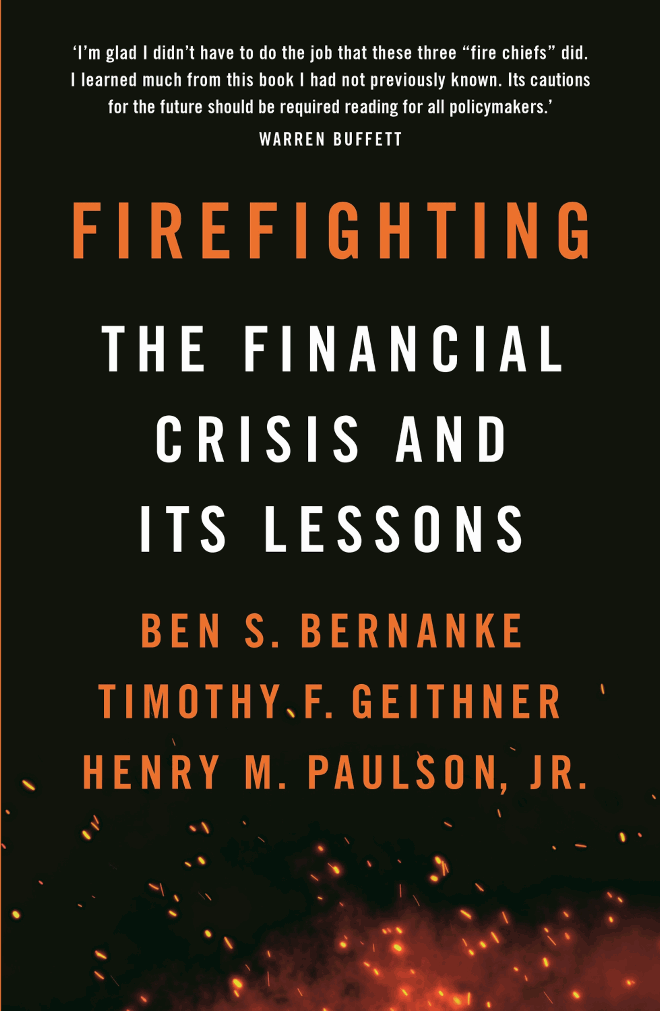Book review

© 2019, Profile Books
Ben Bernanke was awarded the 2022 Nobel Memorial Prize in Economic Sciences, jointly with Douglas Diamond and Philip H. Dybvig, ‘for research on banks and financial crises’, more specifically for his analysis of the Great Depression. Bernanke has served from 2006 to 2014 as the chairman of the Federal Reserve Board of the United States of America. His tenure as Fed chairman coincided with the 2008 financial crisis that has shaken the world and the financial system at its core. After his first term ended in 2009, President Barack Obama nominated Bernanke for a second term, arguing that his leadership helped prevent another Great Depression. Ten years after the crisis, Bernanke wrote the book ‘Firefighting’ together with Tim Geithner—who was United States Secretary of the Treasury from 2009 to 2013 and President of the Federal Reserve Bank of New York from 2003 to 2009—and with Henry Paulson, who was United States Secretary of the Treasury from 2006 to 2009 and served as the CEO of Goldman Sachs for several years preceding that.
The 2022 Nobel prize awarded to Ben Bernanke is a perfect opportunity to bring back to the fore ‘Firefighting’, a book that he co-authored with Tim Geithner and Henry Paulson in 2018 – to wit, ten years after the 2008 crisis which they had to cope with as best as they could. With the benefit of hindsight, the book provides a particularly detailed and nuanced explanation of how the crisis unfolded, and a candid (some would say self-congratulatory) account of how they scrambled to avoid a repeat of 1929.
Ben Bernanke has published dozens of highly cited academic articles, which would be enough to be honored by the Nobel Committee. But what is I think remarkable is his rare ability to transform stern academic knowledge into practical, actionable insights about the real world. Although the decisions made by the trio in the heat of 2008 can be (and have been) criticized – both economically and politically –, I believe that those decisions fended off a total meltdown of collective trust, and with it a full-blown social crisis. One can of course always argue that saving the banks instead of saving households did tear part of the social fabric and sow the seeds of populism, but Ben Bernanke's in-depth knowledge of the 1929 crisis led him to believe that other choices would have led to even more suffering – and probably even worse backlash. In fact, as noted in the book but still not widely recognized, ‘ultimately, the government would earn a substantial return on its investments in U.S. banks, but at the time, the public thought we were giving away its money to the bankers who had just broken the economy’.
Trust collapse and self-fulfilling expectations, mediated by social interactions, can indeed drive social systems (markets, economies) in deeply dysfunctional configurations. As often, the crucial importance of such effects was underlined long ago by Keynes. But Ben Bernanke was himself aware of the disconnect between ‘real’ causes and observed outcomes when he reflected, in 1991, on the ‘small shock, large business cycle puzzle’. In their book, he and his coauthors repeatedly insist on the role of confidence and irrational knee-jerk reactions. They remark, for example, that ‘finance depends on confidence, and confidence is always fragile.’ On the way the crisis billowed after Lehman's default, they write that ‘[i]t felt safer to sell en masse than to try to figure out just how risky individual securities were’. And musing on how they initially misjudged the situation, they note that ‘[their] analyses, focusing on the modest size and scope of subprime, left out the unquantifiable variable of fear.’ Indeed, ‘subprime mortgages [only] made up less than one seventh of all outstanding mortgages in the United States’!
Overall, ‘Firefighting’ is, together with Adam Tooze's ‘Crash’, one of the best resources for anyone interested in understanding the financial crisis and its aftermath. I found the book particularly well-written, concise and engaging, making complex economic concepts and events accessible to a general audience. The book acknowledges mistakes and lessons learned and presents a balanced assessment of the actions that can be taken by policymakers to deal with crises and avoid future ones. As a researcher, I see this book as a major incentive to revisit the old ideas of Keynes & Minsky and make a serious attempt at welding together traditional macroeconomic/financial models with the irrational behaviour of crowds. These can account for unexpected economic crises that are otherwise unfathomable within classical approaches that assume fully informed, rational decisions. But as noted early in the book, ‘financial crises recur in part because memories fade’. Errare Humanum Est, Perseverare Diabolicum.
Additional information
Notes on contributors
Jean-Philippe Bouchaud
Jean-Philippe Bouchaud is co-founder, chairman and chief scientist of Capital Fund Management and adjunct Professor at École Normale Supérieure. Jean-Philippe Bouchaud has received numerous national and international honours: He is elected as member of the French Academy of Sciences. In 2020 he held the Bettencourt Innovation Chair at Collège de France. In 2017 he was named Quant of the Year by Risk Magazine.
